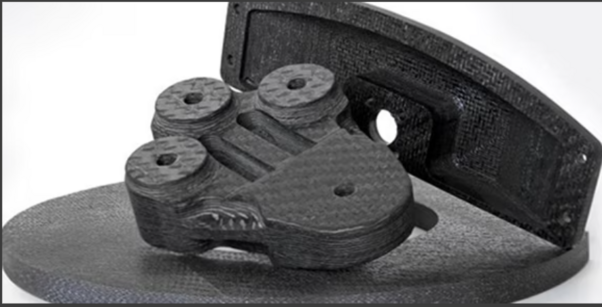Sheet Lamination: Difference between revisions
Jump to navigation
Jump to search
No edit summary |
No edit summary |
||
| Line 1: | Line 1: | ||
== Process description == | == Process description == | ||
[[File:Sheet lamination part.png|right|frameless|602x602px]] | [[File:Sheet lamination part.png|right|frameless|602x602px]] | ||
Sheet Lamination is one of the most flexible Am methods when it comes to materials, as it can accommodate any material that can be formed into a sheet. In Sheet Lamination, each layer of the print is cut out of a roll of sheet stock and stacked and bound using different material dependent processes (most commonly an adhesive). | |||
== Strengths & Weaknesses == | == Strengths & Weaknesses == | ||
* ''' | === Strengths === | ||
* ''' | * '''Speed:''' Sheet lamination need only cut out the perimeter of the each layer, instead of filling in the whole area. | ||
* ''' | * '''Large material selection''': Most materials are sheet stock that is compatible with the bonding process, so it can use a larger variety of materials than other processes. | ||
* '''Micarta printing''': Micarta is a layered material made of adhesive and sheets of material (typically paper, linen, canvas, or carbon fiber). it is a strong light weight material and sheet lamination is a convenient way to rapidly make parts out of this material. | |||
==== Weaknesses ==== | |||
* '''Limited geometries:''' Sheet lamination struggles with the more complex geometries. | |||
* ''' | * '''Surface finish:''' The surface finish of the part is dependent on the material used. | ||
* ''' | |||
{| class="wikitable" | {| class="wikitable" | ||
! | ! | ||
! | !Worst | ||
! | !Best | ||
|- | |- | ||
|volume X/Y/Z (mm) | |volume X/Y/Z (mm) | ||
Revision as of 11:38, 9 October 2023
Process description
Sheet Lamination is one of the most flexible Am methods when it comes to materials, as it can accommodate any material that can be formed into a sheet. In Sheet Lamination, each layer of the print is cut out of a roll of sheet stock and stacked and bound using different material dependent processes (most commonly an adhesive).
Strengths & Weaknesses
Strengths
- Speed: Sheet lamination need only cut out the perimeter of the each layer, instead of filling in the whole area.
- Large material selection: Most materials are sheet stock that is compatible with the bonding process, so it can use a larger variety of materials than other processes.
- Micarta printing: Micarta is a layered material made of adhesive and sheets of material (typically paper, linen, canvas, or carbon fiber). it is a strong light weight material and sheet lamination is a convenient way to rapidly make parts out of this material.
Weaknesses
- Limited geometries: Sheet lamination struggles with the more complex geometries.
- Surface finish: The surface finish of the part is dependent on the material used.
| Worst | Best | |
|---|---|---|
| volume X/Y/Z (mm) | 305/305/102 | 457/449/101 |
| resolution (mm) | .042 | .02 |
| layer height (um) | 200 | 50 |
- Home page
- Material Extrusion
- Powder Bed Fusion
- Vat Polymerization
- Direct Energy Deposition
- Binder Jetting
- Material Jetting
- Sheet Lamination
References
Rosen, Stucker, and Khorasani, Additive Manufacturing Technologies, chap. 9.
“Sheet Lamination - LOM, SL | Make.” Accessed October 6, 2023. https://make.3dexperience.3ds.com/processes/sheet-lamination.
